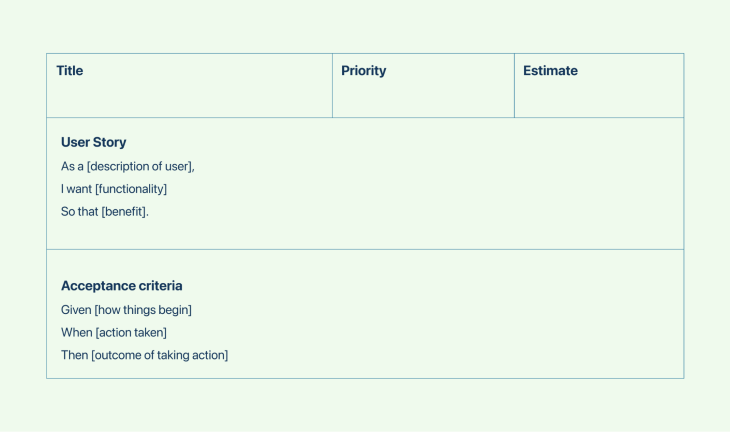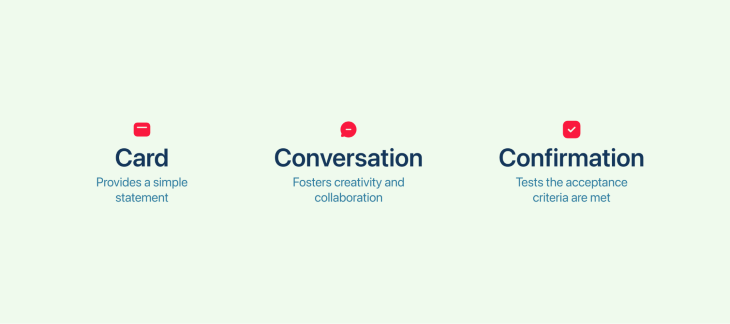User stories play a pivotal role in UX design, helping designers empathize with users and craft meaningful user experiences. Here, we explore what user stories are, why they matter, and how designers use them during the UX design process.

By understanding user stories better, designers can ensure their efforts align with user goals while simultaneously increasing overall user satisfaction and experience.

At the heart of it, a user story is a casual narrative that depicts an interaction between a user or a group of users and a product or service. It outlines their goals, behaviors, and motivations as well as any anticipated outcomes or value they hope to gain from this interaction. We should typically write these narratives from their perspective to allow designers to better empathize with their needs and desires.
User stories are a vital part of user experience design, offering numerous benefits that help create successful, user-centered experiences. Here are a few reasons why they’re crucial:
User stories guarantee a user-centric perspective in design decisions by highlighting user goals, motivations, and pain points as designers develop narratives from their viewpoint. If we implement this user-centric method of working, decisions informed by user needs will result in experiences that are more meaningful and relevant for everyone involved in the design process.
As an effective communication tool, user stories bridge the gap among designers, developers, and stakeholders involved in projects. By explicitly outlining user requirements and minimizing ambiguities and miscommunications, user stories ensure a shared understanding of users and their needs among everyone in the project.
User stories equip designers with insights into the unique situations in which users interact with a product or service. This includes devices, platforms, environments, and scenarios that they must account for when creating solutions tailored specifically for users’ needs. Such insight leads to heightened usability and satisfaction for end users.
User stories serve as a crucial component in Agile methodologies like scrum. By aiding teams in breaking complex features into smaller, manageable tasks, user stories foster iterative and incremental development that favors regular user feedback and adaptation.
The inclusion of user stories into Agile workflows provides designers with an efficient means of promptly meeting user needs while continuously refining designs.
User stories aid in prioritizing features and functionalities based on their value to users. This enables designers to make well-informed decisions about what to include or exclude in designs by evaluating the effects of user stories. And to add to this, this process aids in managing scope while efficiently meeting crucial user needs.
Recognizing the key components that make user stories valuable is crucial to crafting your effective user stories. Let’s take a closer look at these components, complete with examples to illustrate more clearly.
A user story should clearly identify the user or user group for whom the story is being written. This component offers important context and helps designers empathize with the target audience. For example:
“As a frequent online shopper (User), I want to easily filter search results by price range (Action) so that I can find affordable products within my budget (Outcome).”
A well-crafted user story should describe the action or task a user intends to complete, with clear goals in mind and a focus on meeting these demands. For example:
“As a new student (User), I want to easily navigate through the course catalog (Action) so that I can explore available courses and make informed decisions about my academic path (Outcome).”
User stories must clearly outline the desired results or values that a user hopes to attain by performing a particular action. This aspect helps highlight user motivation while setting clear design objectives:
“As a fitness enthusiast (User), I want to track my daily step count and set personal goals (Action) to stay motivated and monitor my progress toward a healthier lifestyle (Outcome).”
User stories must include clear acceptance criteria to prevent confusion and ensure clarity and avoid ambiguity. These conditions must be met for a story to be considered complete, such as:
“As a project manager (User), I want to generate comprehensive reports of team performance (Action) that include data on task completion, time tracking, and individual contributions (Outcome). Acceptance Criteria: The report should be downloadable in PDF format and sortable by date range and team member.”
By encompassing these essential components in user story UX design, an effective user story can convey user goals, actions and expected outcomes to designers, developers, and stakeholders — furnishing clear direction toward user-centric design decisions.
Remember, user stories should be refined over time as you garner more insight and feedback. Revisit and update user stories to keep them in line with user needs throughout your process.

The 3 C’s formula, composed of Cards, Conversation, and Confirmation, is a tried-and-true approach when drafting user stories. This formula presents a structured framework for developing effective stories that encourage collaboration and mutual understanding among team members. Let’s examine its components more closely:
The Card represents the physical or digital depiction of a user story. This concise statement captures the crux of user goals, actions, and outcomes. It serves as a reminder and starting point for conversations and discussions. A well-crafted Card should provide just enough information to spark further exploration.
The Conversation refers to the collaborative dialogue and discussion surrounding a user story. It involves stakeholders, designers, developers, and other team members engaging in dialogue to gain a better understanding of user needs and expectations.
Through dialogue, the team can uncover potential obstacles or hurdles and align expectations as they delve into the details and generate ideas to address possible challenges or opportunities for improvements.
Confirmation reflects the criteria or conditions that must be met to consider a user story complete. These serve as an effective checklist ensuring that implementation efforts fully address all needs and expectations of users, guiding testing, and validation processes.
User stories must revolve around the needs and goals of users. Prioritize their perspective, taking care to address pain points and motivations within each story. By centering user needs in our design process, we ensure that we meet the requirements of our target audiences effectively.
Adopt a clear and standardized format for your user stories. A structured template covering user, action, and outcome components will facilitate understanding and comparing stories across projects while enhancing communication among teams.
User stories should stand on their own and offer independent value. Whenever possible, eliminate dependencies between stories as much as possible to permit prioritization and flexibility during development, allowing teams to focus on delivering the features that users value most first.
Ensure that user stories are specific and come with testable acceptance criteria. Specificity provides clarity and leaves no room for ambiguity. Testable criteria aid in evaluating the implementation of user stories, ensuring shared understanding of what needs achievement.
The creation of user stories should be a collaborative effort, involving stakeholders, designers, developers, and other team members. This collaborative approach promotes shared understanding, increases collaboration, and gathers diverse perspectives and insights.
User stories should be adjustable, not set in stone. Regularly iterate and modify them based on user feedback and changing requirements. This ensures that they remain relevant and in sync with user needs throughout the design process.
Regularly validate user stories through user testing, prototyping, and feedback loops. This constant validation and learning help to create better user experiences and drive designs towards success.
As a frequent traveler (User), I want to easily search for and book flights (Action) so that I can plan my trips efficiently and save time (Outcome).
Acceptance criteria: The flight search should allow filtering by dates, destinations, and airlines, and the booking process should be intuitive and secure.
Explanation: This user story is clear, detailed, and provides acceptance criteria with ample guidance for implementation. It addresses user needs, desired actions and expected outcomes.
As an online shopper (User), I want to receive order confirmation emails with detailed information (Action) so that I can track my purchases and ensure accuracy (Outcome).
Acceptance criteria: The order confirmation email should include the order number, item names, quantities, prices, shipping details, and a link to track the shipment.
Explanation: This user story clearly defines the user, their desired action, and the expected result. Additionally, there are specific acceptance criteria which outline all necessary details that must be included in order confirmation emails.
As a student (User), I want to be able to download lecture notes from the course website (Action) so that I can access them offline and review them at my convenience (Outcome).
Acceptance criteria: The course website should provide a download button next to each lecture, and the downloaded files should be accessible offline and in a readable format.
Explanation: This user story is specific, addresses an identifiable user need and includes clear acceptance criteria which outline what functionality must exist for downloading lecture notes.
As a website visitor (User), I want the website to be better (Action) so that I can use it easily (Outcome).
Explanation: This user story is too generalized and lacks specificity. It does not provide clear guidance as to which improvements or usability aspects should be addressed.
As a mobile app user (User), I want the app to be more user-friendly (Action) so that I can enjoy using it (Outcome).
This user story is too vague and lacks specificity, offering no guidance as to which aspects of user friendliness require improvement or what features or functionalities need attention.
User stories are an indispensable component of UX design, enabling designers to empathize with users, understand their needs and design meaningful experiences for them.
By empathizing with user goals and expectations, UX professionals can craft user-centric designs that align with user goals and expectations. With user stories as a tool for collaborative design processes and effective communication among teammates, these professionals can produce products and services that truly meet them all.
Header image source: IconScout
LogRocket's Galileo AI watches sessions and understands user feedback for you, automating the most time-intensive parts of your job and giving you more time to focus on great design.
See how design choices, interactions, and issues affect your users — get a demo of LogRocket today.

AI wireframe tools are everywhere but they don’t all work the same way. I tested Visily, UX Pilot, Uizard, Mokkup AI, and Figma Make to see which tools are best for non-designers, fast iteration, and serious UX work.

Small actions can have large consequences in complex systems. Here’s how UX designers can manage dependencies so users feel informed and in control rather than blocked or blindsided.

This article examines when hero sections are necessary in digital products, when they create friction, and how to evaluate them using UX goals, primary actions, user flow impact, and real-world alternatives.

AI speeds up tasks like research synthesis, ideation, and first-draft wireframes, but it can’t replace clarity, taste, or decision-making. Here’s a grounded look at what AI actually does well in UX right now.